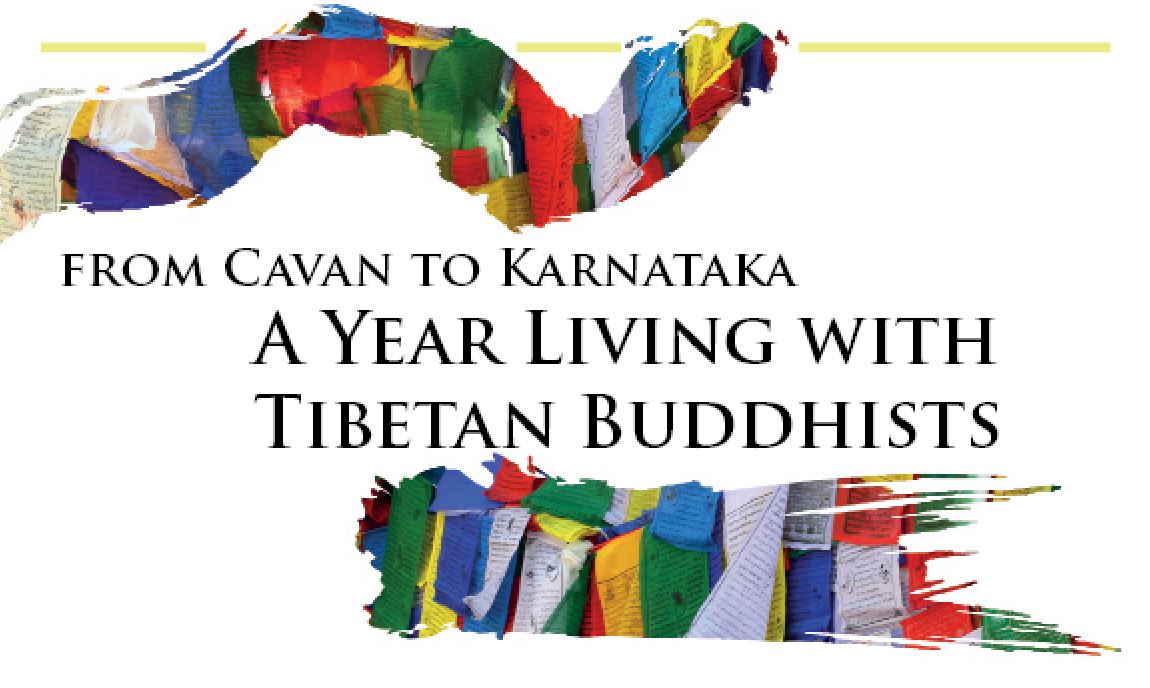From Cavan to Karnataka - a year living with Tibetan Buddhists

As more and more crimson-robed monks piled into the jeep, squashing me into a corner against the window, I began to wonder if we might go for a Guinness World Record. It was early in the morning, about half-seven, but the Indian sun was already heating up despite the fact it was winter time. I was staying in the brand new guesthouse of Gungru Khansten Monastery in the vast Tibetan settlement of Mundgod known as “Little Tibet” in the southern state of Karnataka. In the monastic areas of the settlement, even the shops, restaurants and internet centres are manned by monks. Packed to the brim, our jeep set off for Ganden Monastery where His Holiness the Fourteenth Dalai Lama would give the first of his teachings on “Lam Rim: The 18 Great Stages on the Path” (i.e. the path to Buddhahood or awakening).
We were not long on the dusty, red dirt track of a road, dodging buses, motorised rickshaws, motorcycles and pedestrians, when I realised we wouldn’t win any record. There were countless vehicles spilling over with monks, many balanced precariously on roofs and bumpers. They had come in their tens of thousands, along with lay people from all over India, Nepal, Sikkim, and even the homeland of Tibet to hear their spiritual leader. There were also foreigners from various countries, including myself travelling in the company of a high Tibetan lama who resides in Ireland. I had no idea I would end up in India when I pledged a year of my life to serve Panchen Otrul Rinpoche and Jampa Ling, his centre in the heart of the Irish countryside.
It all began five months before, when I drove to Bawnboy, Co. Cavan with a suitcase of clothes, a pair of wellingtons and my cat Emma. A brown road sign pointed me out of the village, along a winding country road and up an avenue lined with woodland that led to a great stone Victorian mansion. Tibetan prayer flags fluttered from tall trees. Dogs raced over the lawns and heather beds. A blue lake lay in the distance surrounded by green hills. Statues of the Buddha smiled benignly from plinths and window sills. It was a damp July, but that day was sunny. Still, I felt the inevitable pang of dread that precedes any new enterprise. Instead of my usual solitary work as a writer of novels and sometimes screenplays, I was about to join a small community of volunteer workers to help run a Tibetan Buddhist Centre.
My reasons for the move were personal. I had just crawled out of a very bad year which saw my editor fired and book deals cancelled, as well as the collapse of a film deal thanks to theft on the part of my producer’s accountant. But that was only the surface mire. There was a deeper distress and as I eventually came to perceive it, I came to appreciate the misfortune that had revealed it. In truth, I had been pursuing material goals for so long and had become so stressed and unhappy that I had lost sight of why I had ever wanted to be a writer in the first place. Somewhere in the quest for fame and fortune, I had lost the joy of delving into the realm of the imagination, the thrill of exploring language, and the satisfaction of harvesting vision.
“When did mission become work?” another writer, Kate Thompson, said to me one day. Could Jampa Ling help me with that question? Better still, could it help me get back to that precious place where work was mission?
I already had a long relationship with the centre and its spiritual director, Panchen Otrul Rinpoche. My first visit was in 1990 when the centre was newly established by the Venerable Tenzin Choeden or Margery Cross as she was known then, before she was ordained as a nun by the Dalai Lama. Over the decades, I attended teachings by Rinpoche – his title means “precious one” – participated in work weekends, brought my daughter to the children’s camp, and celebrated Losar (New Year) and other Tibetan festivals. During that time, the centre expanded and the stables which once housed rescued donkeys were renovated into a guesthouse to accommodate the ever-increasing number of visitors from all over the world. From my own fairly constant visits, I was familiar with the work routines, the daily prayer and meditation practices, and the general community at large. In short, I was ready to hit the deck running.
Anyone who has lived in community knows that the work is unending. There are always jobs to be done, both indoor and out. The description of my activities ranges anywhere from painting benches to caring for guests, making beds to guiding meditations, hanging out the washing to taking cats to the vet. Did I mention digging up potatoes in the walled garden? Mothering young WOOFERS? (World-wide workers on organic farms). It seems as if every skill or ability I have managed to acquire in my life is being called into play and put to good use. Soon I will be facilitating a retreat – I call it “Spring Treat” – which offers a weekend of guided meditation, Chi Gong, mindful walking in the woods, and expression through artwork and group sharing. That others working at the centre are willing to help with the weekend is just one of the many pluses here. Whether staff or volunteer, part-time or full-time, office or garden or house worker, everyone joins in to get things done. Indeed, our guests are often shocked to find Rinpoche himself hoovering the carpet or washing the dishes! Indeed, this was one of the many reasons why I choose to serve this lama when I am anything but a follower by nature and have little time for hierarchies.
The young Karl Marx wrote of how crucial our work is to our well-being; that alienation from work leads to alienation from life. Albert Einstein wrote that only a life lived for others is worthwhile. The path of Buddhism asks us to contribute to the happiness of all sentient beings; and we are taught that by helping others, we help ourselves. My work at Jampa Ling has created a well-spring of joy, purpose and meaning in my life. And that’s before I even begin to acknowledge the effects of daily prayer and meditation and the inspirational teachings of the lama. Previously parched in a desert of materialism, my imagination has begun to flourish once more. The desire to write has been re-kindled, in particular about my relationship with Rinpoche and Tibetan Buddhism. But first I will complete my year’s commitment to Jampa Ling which has given me back my spirit.
I began this article in India and will end it in Outer Mongolia. This summer I shall be in the company of the lama when he goes to oversee the many charities and work projects he has established there under the name of ASRAL (“care” in Mongolian). We’ll be crossing the Gobi Desert. Sometimes one’s imagination just needs a little watering.
O.R. Melling has a B.A. in Celtic Studies and an M.A. in Mediaeval Irish History. She is an accomplished fantasy writer. Her books have won awards and been translated into various languages. Her new work of mystical fiction People of the Great Journey is published by Hay House. For more see www.ormelling.com
Latest Issue
Upcoming Events
-
17/04/2020 to 26/04/2020
-
18/04/2020
-
23/04/2020
-
15/05/2020 to 23/05/2020
-
16/05/2020 to 17/05/2020
Recent Articles
Article Archive
- May 2017 (4)
- June 2017 (11)
- July 2017 (7)
- August 2017 (2)
- September 2017 (1)
- October 2017 (3)
- November 2017 (4)
- December 2017 (3)
- April 2018 (2)
- June 2018 (2)

